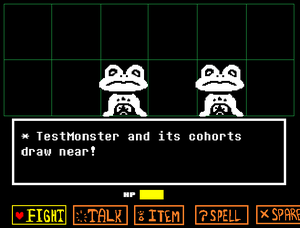When you encounter a monster, you will enter a FIGHT.
While you are in a FIGHT, strike up a friendly conversation.
Encounters are the battles (FIGHTs) with enemies that either occur at random or in predetermined locations. During a battle, the protagonist can interact with an enemy in many different ways through ACTs, but the enemies present must be either killed or spared to end the encounter. Alternatively, fleeing can also end the battle, but this method does not always guarantee success and can lead to a skipped turn instead.
During an encounter, the options FIGHT, ACT, ITEM, and MERCY, the name chosen at the beginning of the game, LV, and HP are all visible like in typical RPGs.
Protagonist's turn[]
In the middle of the screen, some text is displayed in narrative style:
- At the start of the encounter, flavor text is given on the nature of the encounter (e.g. "Whimsun approached meekly!")
- After the first turn, the flavor text usually describes one of the monsters in battle, which may change depending on the ACT options the protagonist has chosen.
- The flavor text can also describe the protagonist's actions whether it is from doing ACTs or as a story element.
FIGHT[]

The protagonist is prompted to pick a monster to attack. The protagonist can attack one monster each turn.
- If a monster can be spared to remove them from battle, their name may be colored yellow, white or pink, depending on the conversation the protagonist had with the third Froggit in the three-frog room in the Ruins (room_ruins13). Yellow is the default color for spareable monsters.
- Selecting FIGHT triggers a quick-time-event in which 1 bar (or more with certain weapons) slides across a meter, and [Z] / [Enter] must be pressed to attack. Hitting [Z] / [ENTER] while the bar is at the center mark causes the most damage.
- Allowing the bar(s) to slide all the way across the meter results in them fading out and a miss. This method is equivalent to selecting Spare, except that it does not cause any monsters to leave the battle, even if the Spare text is on.
- The protagonist's weapon determines the speed and number of bars, as well as the effect that plays after an attack if it is to succeed.
- The Tough Glove has its own quick-time event where [Z] / [ENTER] must be pressed four times as fast as possible to deal maximum damage.
- If the attack depletes the monster's health to zero, they dissipate into dust and fade out of the battle, thus killing them. Normal monsters take a minimum of one to four hits to die while bosses can take much more. It is possible to kill most monsters in one hit on the Genocide Route.
- Once a monster's HP is low enough, they can be spared. This method can be used to end a battle if one neglects the ACT menu. Bosses and mini-bosses are an exception.
- It is possible to kill any monster or a boss in one hit before choosing to Spare them while their name is colored. This method is known as Betrayal and can trigger unique dialogue in certain circumstances.
ACT[]

The protagonist is prompted to select a monster, and is then given one or more ACT options which are specific to that monster.
- The protagonist can always Check any monster in the encounter, with very few exceptions.
- ACTing is another way to end battles peacefully (and is usually the pacifist tactic players use as opposed to FIGHTing and draining their HP to a minimum).
- In some situations, ACTing ends the next turn immediately and the monster can be spared.
- ACTs may need to be performed in a certain order to allow a monster to be spared (e.g. sparing Greater Dog).
- Only in the second half of the Asriel Dreemurr fight the ACT button changes to a rainbow SAVE button, depicting a SAVE Point. Selecting SAVE brings up a list of characters: Undyne, Alphys, Sans and Papyrus, Toriel and Asgore. Selecting a character enters the corresponding Lost Soul encounter.
ITEM[]

- Using consumable items regains health. Some consumable items are capable of increasing stats.
- Using equipment items other than the Bandage or Stick equips them.
- Using the Bandage acts like using a consumable item.
- Using the Stick throws it. Using the Stick can have different effects play out, like making the Snowdin Canine Unit and Endogeny immediately spareable, increasing the ratings on Mettaton EX's battle, etc. After usage in the overworld, or if usage in battle causes no special event, the protagonist "picks it back up" and can use it again.
MERCY[]

Sparing means that the protagonist does not want to fight. The protagonist is encouraged on multiple occasions on their journey to show mercy to the monsters they fight.
- Selecting Spare removes any monster from battle if their name is colored.
- The spare color begins as yellow, but can be changed to white and finally pink by talking to the third Froggit in the three-frog room in the Ruins.
- If the Spare option is not colored, selecting it does nothing in most situations and merely results in skipping a turn.
- Some monsters, notably bosses, require the protagonist to continue sparing even if their name is not colored to progress the encounter peacefully.
- Selecting Flee makes an attempt to escape the encounter. If successful, the protagonist's SOUL is shown sprouting legs and walking away, and the game returns to the overworld. This option is unavailable in many encounters, most notably bosses.
- MERCY is not available during Asgore's Battle, as he destroys it with his trident, and it only returns when he has been defeated.
Enemy's turn[]
The enemy may have some dialogue before attacking. The protagonist can skip the forming dialogue with [Z] (during some boss fights, particularly the ones with multiple dialogue bubbles per turn, [X] must be pressed first, like in the overworld). In some situations (such as some cases when the dialogue plays at a slower pace), the dialogue cannot be skipped.
The protagonist's SOUL is placed inside the Bullet Board. The enemy attacks the SOUL in the box using bullets, weapons, or other alternative offensive options. The SOUL can be controlled using the player's selected input option, such as the keyboard's default arrow keys. The shape of the bullets used in enemy attacks varies, depending on the enemy being fought. When multiple enemies are fought, their attacks overlap in the Bullet Board.
In most boss battles (and the mini-bosses Muffet and Mad Mew Mew), the color of the SOUL is changed to a certain color. The enemies' attack colors also change in certain battles.
End conditions[]
An encounter may end through the following ways:
Win[]
All monsters are removed from battle, and the music stops. EXP and GOLD are rewarded depending on the monster(s) fought and whether the protagonist killed the monster(s) or did specific ACTs that give them GOLD. Monsters that are removed from battle are either grayed out with a different sprite (usually their "hurt" sprite) or absent from the battlefield entirely.
Lose[]
The protagonist's HP reaches 0. The screen is blacked out, the music suddenly stops, and the SOUL breaks in half before shattering, which results in a game over. Dialogue in Asgore's sound bite encourages the protagonist to stay determined. If the player decides to continue, the game loads to the last SAVE Point before the encounter. There are some exceptions when it comes to the SAVEs at some points in the game (such as the elevators in Hotland). However, the outcome of a loss has exceptions during Photoshop Flowey, Asriel, and Papyrus's battles.
Flee[]
The protagonist flees from battle and returns to the overworld. If earned, they are rewarded with EXP or GOLD for each monster killed or spared during the encounter.
Trivia[]

- Screenshots of an earlier version of Undertale from the "UnderBound 2" joke post[1] reveal that "ACT" was originally called "TALK," "MERCY" was called "SPARE," and a "SPELL" button was planned to be included but was scrapped.[2] This asset can still be found in the game's files.
- The "SPELL" button returns in Deltarune as "MAGIC" which can be used in ACTs and with Tension Points (TP) as a means of limiting it.
- The shade of yellow in the highlighted FIGHT button is lighter in comparison to the others.[3]
- Wearing the Bandage makes fleeing the battle guaranteed (except in Hard Mode), which can be useful for speedruns.
- When holding [X] during the enemy's turn, the SOUL moves slower. This method can be useful if the protagonist is currently in tight sections where precise movement is needed. It can also be used to move slowly across the Bullet Board while enemies are directly shooting at the protagonist, effectively taking a while to get to a corner, in which case, the turn is already over.
- If a monster with no hurt sprite is spared, it is replaced with a grayed out Aaron sprite, which is the sparing placeholder sprite. This replacement is likely because Aaron's name is the first in the alphabet within the game files.
- On the Neutral Route and True Pacifist Route, sparing Papyrus, Undyne, Mettaton EX, and Asriel Dreemurr causes the encounters in Snowdin, Waterfall, Hotland, and the Ruins, respectively, to stop, whereas during the Genocide Route encounters only stop occurring after killing Mettaton NEO.
- When attacking in a cutscene, such as the one that kills Sans and Asgore, the attack animation defaults to a curled, red slash, even if the player has a weapon equipped that normally has a distinct attack animation. This also applies to all attacks made against Photoshop Flowey.
- In a Nintendo Everything interview, Toby Fox explains that the ACT and MERCY commands were inspired by Shin Megami Tensei.[4]
References[]
- ↑ Some people actually think a joke/troll post I made in a friend's forum topic about Undertale originating as an EB ROM hack is true... - Toby Fox (@tobyfox) on Twitter, March 12, 2016.
- ↑ Toby Fox (4 February 2013). "UnderBound" Retrieved on 9 December 2015.
- ↑ Imgur
- ↑ The ACT and MERCY commands were inspired by Shin Megami Tensei. I played just a bit of that game and loved talking to the monsters in it. Since I liked it so much, I decided I wanted to make a game where that was actually the main focus. - Undertale creator on the games that served as inspiration, changes during development, and more (@NE_Brian, October 27, 2018.) Nintendo Everything.
